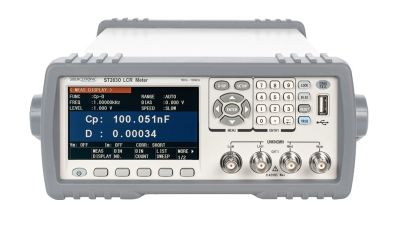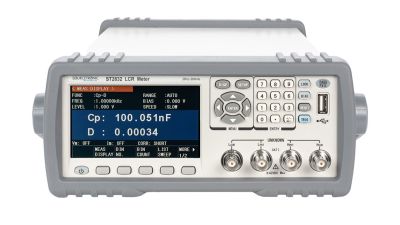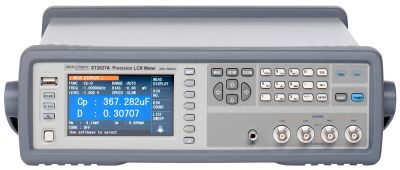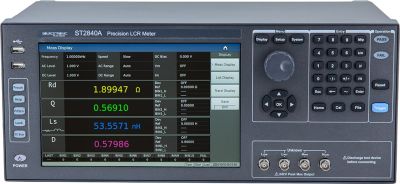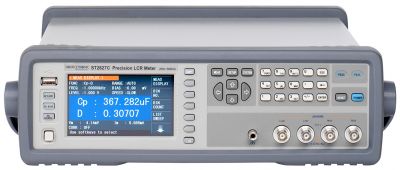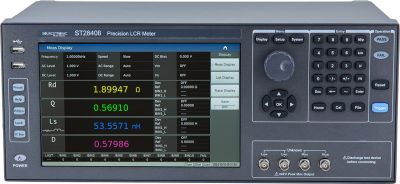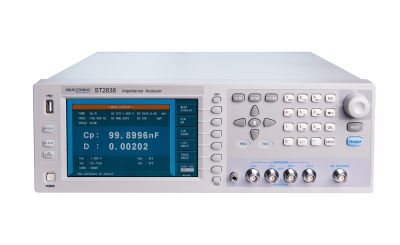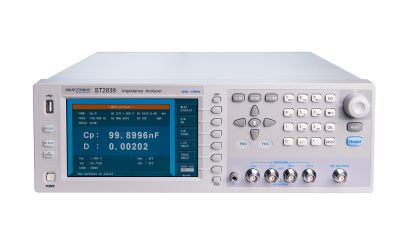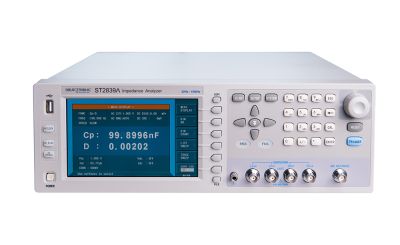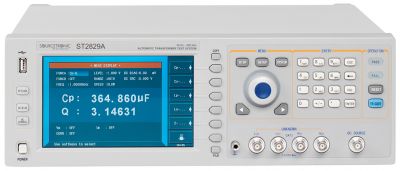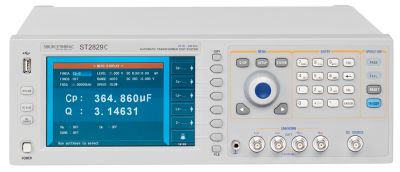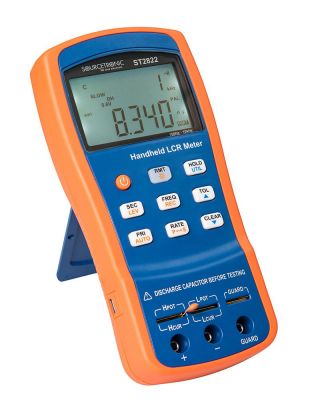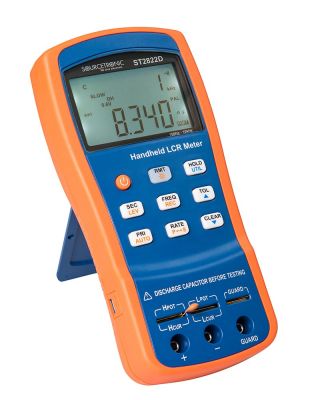Certified quality management system
LCR Meters
LCR meters measure inductive, capacitive and ohmic resistances quickly and with high precision.
The LCR meter and capacitance bridge can be used to measure alternating current resistances and phase angle as well as components' performance. The special resolution of these LCR meters with 6 digits display and the high testing voltage up to 10V allow exact assessments of the capacitance of capacitors and the inductivity of coils. Particularly talked about is the convenient judgement comparator function of this first class capacitance bridge. Check the quality of your devices simply with the GOOD and BAD values. The device can be niftily controlled by a PC or an SPS with the RS232 interface or the fast 24-volt control interface. An LCR meter with this command structure is brilliantly integrable into LabView or into testsystems with existing software. The reliable LCR meter is meant for, in the most part, use in manufacturing and assembly as well as universities and laboratories. The inductance meter from the DU series is at the same time a first class multimeter and applicable as an ESR meter, for example for the measurement of Electrolyte capacitors. Additional multimeters are to be seen in the Sourcetronic measuring technology shop. The LCR measuring tools are unique in their large bright displays which are viewable from all angles and from a distance. All in all a top flight LCR measuring bridge, in a robust case.
+49 421 277 9999
- Frequency range: 50Hz - 100kHz
- Basic accuracy: 0.05%
- Test parameters: |Z|, |Y|, C, L, D, Q, θ(DEG), θ(RAD), Δ%, DCR
- 4.3" TFT LCD display
- Interfaces: RS232, USB, HANDLER, GPIB (optional)
- Frequencies: 20Hz - 200kHz
- Basic Accuracy: 0.05%
- Test parameter: |Z|, |Y|, C, L, D, Q, θ(DEG), θ(RAD), Δ%, DCR
- 4.3" TFT LCD display
- Interface: RS232, USB, HANDLER, GPIB (optional)
- Internal 0 - ± 5V/50mA bias source
- Frequencies: 20 Hz - 300 kHz
- Accuracy: 0.05%
- Test parameters: |Z|, |Y|, C, L, X, B, R, G, D, Q, θ(DEG), θ(RAD), DCR, Δ
- 4.3" LCD-color-display
- Interfaces: LAN-LXI, RS232C, Handler, USB, GPIB (optional)
- Internal DC-BIAS Source: 0V - ±5V / 0mA - ±50mA
- Transformer parameter test function
- Frequency: 20Hz – 500kHz, accuracy 0.01%
- Test Parameters: Cp/s, Lp/s, Rp/s, |Z|, |Y|, R, X, G, B, D, Q, θ, Vac-Iac, DCR, Vdc-Idc
- Basic Accuracy: 0.05%
- 1280xRGBx800, 10.1" Color Touch Screen
- Graphical representation of parameters over frequency, AC test voltage/current, or DC-BIAS voltage
- Speed: under 1ms
- Interfaces: USB HOST, USB DEVICE, LAN, Handler, External DC BIAS, RS232C
- Frequencies: 20 Hz - 1 MHz
- Accuracy: 0.05%
- Test parameter: |Z|, |Y|, C, L, X, B, R, G, D, Q, θ(DEG), θ(RAD), DCR, Δ
- 4.3" LCD-color-display
- Interfaces: LAN-LXI, RS232C, Handler, USB, GPIB (optional)
- Internal DC-BIAS Source: 0V - ±5V / 0mA - ±50mA
- Transformer parameter test function
- Frequency: 20Hz – 2MHz, Basic accuracy: 0.01%
- Test Parameters: Cp/s, Lp/s, Rp/s, |Z|, |Y|, R, X, G, B, D, Q, θ, Vac-Iac, DCR, Vdc-Idc
- Accuracy: 0.05%
- 1280xRGBx800, 10.1" Color Touch Screen
- Graphical representation of parameters over frequency, AC test voltage/current, or DC-BIAS voltage
- Speed: under 1ms
- Interfaces: USB HOST, USB DEVICE, LAN, Handler, External DC BIAS, RS232C
- Frequencies: 20Hz - 2MHz
- Basic accuracy: 0.05%
- Resolution up to 0.1mHz
- Built-in 0-100mA / 0-40V DC voltage source
- AC signal current range: 50μArms - 100mArms
- 800x600 LCD color display
- Sweep via 201-point list
- Interfaces: RS232, USB, LAN-LXI, HANDER, GPIB (optional), SCAN (optional),external DC BIAS
- Test speed: up to 5.6 ms
- Test Frequency: 20Hz - 10MHz
- High accuracy:Auto-balance bridge technology, 4-terminal pair
- Basic accuracy: 0,05%
- High stability and consistency:Up to 15 test ranges
- High resolution:7- inch, 800×600
- Test Frequency: 20Hz - 5MHz
- High accuracy:Auto-balance bridge technology, 4-terminal pair
- Basic accuracy: 0,05%
- High stability and consistency:Up to 15 test ranges
- High resolution:7- inch, 800×600
- Frequencies: 20Hz - 300kHz
- Basic Accuracy: 0.05%
- Test parameters: C, L, R, Z, Y, X, B, G, D, Q, θ, DCR, Vdc-Idc
- 800x480 7" LCD-color-display
- Interfaces: USB, RS232, Handler, DCI, (GPIB option)
- Internal DC-BIAS Source: 0V - ±10V / 0mA - ±100mA
- Graphical analysis function based on frequency, AC voltage or DC bias
- Frequencies: 20Hz - 1MHz
- Basic Accuracy: 0.05%
- Test parameters: |Z|, |Y|, C, L, X, B, R, G, D, Q, θ, DCR, Vdc-Idc
- 800x480 7" LCD-color-display
- Interfaces: USB, RS232, Handler, DCI, LAN-LXI (GPIB option)
- Internal DC-BIAS Source: 0V - ±10V / 0mA - ±100mA
- Graphical analysis function based on frequency, AC voltage or DC bias
- Frequencies: 100Hz - 10kHz
- Basic accuracy: 0.25 %
- Test parameters: L, C, R, Z / D, Q, θ, ESR
- Backlight LCD-display
- Interface: Mini-USB
- Measuring time: 250ms
- Comparator function
- Frequencies: 100Hz - 10kHz
- Basic accuracy: 0.1 %
- Test parameters: L, C, R, Z / D, Q, θ, ESR, DCR
- DCR Measuring Speed: 3meas/sec
- Backlight LCD-display
- Interface: Mini-USB
- Measuring time: 250ms
- Comparator function
Sourcetronic LCR Meter - Zero calibration
With an LCR meter it is feasible to determine the impedances, which means the complex resistances of two-terminal components. LCR measuring devices are able to measure current, voltage and phase shift and calculate from that the LCR values, which can be represented in all possible forms (e.g. Z, R and X, series equivalent circuit Ls, Cs and Rs or parallel equivalent circuit Lp, Cp and Rp, etc.). There are portable handheld LCR measuring devices which are usually easy to use and there are also table and laboratory LCR meters in various sizes and ranges from 1 kHz to 100 MHz and even beyond.
How do I determine the correct LCR measuring device for my requirements?
In addition to the measuring ranges to be determined, the frequency range must be specified in each case, which is decisive for the price of the devices. Ordinarily the test specimens should be measured with the frequency with which they are operated later. Moreover, a LCR bridge often has very helpful functions, e.g. the comparator function, or the list-sweep-function. In the comparator mode, you can enter threshold values for the test specimens and the measuring device automatically evaluates to "GOOD" or "BAD" and can control a sorter with several compartments. The list-sweep function offers the possibility to automatically test a specimen with different frequencies, similar to an impedance analyzer, with the extraordinary well-equipped ST2829 series even with graphical frequency response over up to 801 frequency points. All in all, a LCR meter is suitable for direct and precise measurements of inductors, capacitors and resistors under different test frequencies. At the same time the test range can be selected manually or automatically. The LCR meter can also be operated fully automatically, e.g. via the interfaces RS-232, USB, GPIB, LAN or Handler. With specialized control software like our own ST© Meter, the measurements can be logged and evaluated accordingly.

